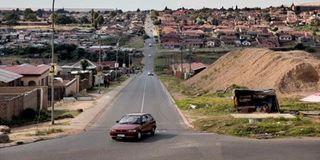
A sedan car approaches an intersection in Soweto. A World Bank report said South Africa is the most unequal country in the world.
Soweto, a vibrant township nestled within Johannesburg, isn’t just a collection of houses. It’s a living testament to South Africa's tumultuous past, a crucible of resilience, and a breeding ground for countless ‘firsts’ that continue to shape the nation's identity.
Located southwest of Johannesburg, Soweto derives its name from the acronym ‘South-Western Townships’.
The townships that now comprise Soweto emerged from the shantytowns and slums that sprang up as Black labourers migrated from rural areas, particularly between the two World Wars.
This growth was unplanned, leaving the developing township without basic municipal services or government oversight. In 1948, slum clearance and permanent housing initiatives were launched, accompanied by the establishment of both local and national governance.
Despite the hardship, a spirit of resistance took root. Soweto became a hotbed of activism. In 1976, student protests erupted against the imposition of Afrikaans as the medium of instruction in schools.

The townships that now comprise Soweto emerged from the shantytowns and slums that sprang up as Black labourers migrated from rural areas, particularly between the two World Wars.
What started as a peaceful demonstration turned into the infamous Soweto Uprising, where hundreds of young lives were tragically lost to police brutality.
The uprising resonated across the globe, becoming a powerful symbol of the fight against racial segregation.
But beyond its role in the struggle for liberation, Soweto's legacy encompasses a myriad of ‘firsts’ that have profoundly impacted South Africa's social, cultural, and political fabric. And now, from Nobel Prize winners and iconic sports stars to musical legends, Soweto has carved its place in history and captured the hearts of people around the world.
“Having grown up in Soweto, I'm still amazed by how iconic the township has become. From the birthplace of football stars and music legends, to its historic monuments, acclaimed actors, and tourist hotspots, Soweto has undergone a transformation. It's no longer the intimidating place many imagine; today, Soweto welcomes and captivates visitors from around the world,” explains Tokelo Mokhesi, a local commentator.
The famous Vilakazi Street in Soweto—Orlando, holds a unique distinction as it is the only street in the world where two Nobel Prize winners, Nelson Mandela and Archbishop Desmond Tutu, once resided.
Today, the Mandela Museum in Vilakazi Street stands as a poignant reminder of the pivotal moments that unfolded within its walls, including Mandela's capture in 1962.
Soweto was not only the home of Nobel laureates but also of Indian non-violent activist Mahatma Gandhi, whose modest residence served as the launchpad for his transformative legal career.
The township also has a healthcare facility, Chris Hani Baragwanath Hospital, which is the largest hospital in Africa with 3,400 beds.
On the sporting front, Soweto is home to Africa’s and South Africa’s largest stadium, the FNB Stadium, also known as Soccer City.
The venue has witnessed several sporting triumphs. It hosted the opening game of the 2010 FIFA World Cup, the final and saw the first goal of the World Cup being scored by Bafana Bafana and Kaizer Chiefs legend Simphiwe Tshabalala, who is born and bred in Soweto.
Another stadium in Soweto, which is a place of excellence, is Orlando Stadium, the home of the 1995 CAF Champions League winners, Orlando Pirates. Built specifically for Black South Africans, Orlando Stadium holds the distinction of being the first-ever sports facility in a residential area designated for Black residents. This stadium became a symbol of inclusivity and a platform for sporting achievements.
One of Africa’s most successful coach, Pitso Mosimane, with three CAF Champions League titles, cut his football teeth in Soweto. “Pitso was like any normal boy ekasi. He came from a privileged family,” recalls football coach Paradise Moeketsi.
“His father had some businesses. Pitso was a loxion boy, but ubeyintwana le [he was that kid] that you’d never find in trouble. He dreamt big.”
While Mosimane’s family home was in Senaoane [Soweto], his heart was in Rockville.
“In Rockville, we played football until late in the evening. There was a pitch with grass there, so we were privileged to have that facility. “Rockville is close to Senaoane. Pitso’s life was in Senaoane. He only went to Senaoane to sleep, but he spent all his time in Rockville,” Moeketsi says.
Portia Modise, the first African footballer to score 100 international goals, was born in Meadowlands, Soweto.
“She was around 12 when I discovered her. It was in Soweto, and I was walking past the ground when I first saw her. I said this kid is phenomenal. and didn’t realise she was a girl; I thought she was a boy. I only realised after some time that she was a girl. It was tough for girls back then,” Moeketsi, a founder of the School of Excellence, adds.
Other football icons such as Lucas Radebe, Kaizer Motaung Sr, founder of the country’s biggest football club Kaizer Chiefs, and Doctor Khumalo honed their skills on the township's dusty fields, inspiring future generations and elevating South African football to international acclaim.
Radebe went on to captain one of the biggest and oldest clubs in the world, Leeds United, becoming a club legend.
Soweto has also been the birthplace of South African sounds. The biggest township in SA is credited as one of the founding places of Kwaito, a vibrant musical genre that later gave birth to Amapiano, the pulsating music taking the world by storm.
The music emanating from Soweto reflects the vibrancy and dynamism of its people, serving as a powerful expression of their triumphs and tribulations.
Moreover, Soweto has given birth to a multitude of remarkable individuals who have not only made their mark on the world stage but have also continued to inspire and uplift their communities.
From the acclaimed singer Yvonne Chaka Chaka and award-winning actors such as Presley Chweneyagae to influential politicians like Cyril Ramaphosa, the township has been the crucible from which extraordinary talent and resilience has emerged, shaping the narrative of South Africa on the global platform.
Today, Soweto with over 1.3 million residents is a developing area with shopping malls, a theatre, and sporting facilities. It's also a cultural hub with its own music genres, TV channel, and a vibrant artistic scene.







